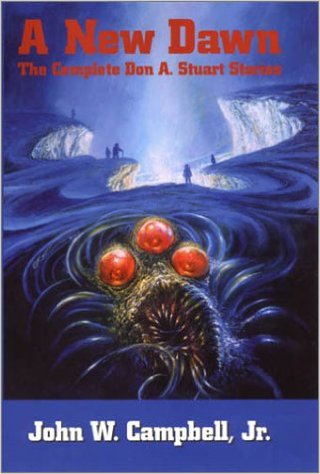This time out, I’m taking a brief look at one of the high-quality NESFA Press collections of SF author short fiction. This one contains all of John W. Campbell, Jr’s short fiction written under his “Don A. Stuart” pseudonym, plus a couple of previously unpublished (in book form) articles also written by Campbell under the Stuart handle. The collection starts off with an excellent introduction, “The Man Who Lost the Sea”, written by Barry N. Malzberg, giving a short but fascinating examination of Campbell’s career. This is followed by sixteen stories, and finishes off with the two essays.
TITLE: A NEW DAWN: THE COMPLETE DON A.STUART STORIES
AUTHOR: John W. Campbell, Jr.
EDITED BY: James A. Mann
CATEGORY: Short Fiction
SUB-CATEGORY: Author Collection
DUSTJACKET ART: Bob Eggleton
FORMAT: Hardback, 464 pages
PUBLISHER: NESFA Press, US, 2003
ISBN: 1-886778-15-9
CONTENTS (16 Stories, 2 Articles):
- Introduction: “The Man Who Lost the Sea” (2002) by Barry N. Malzberg
- “Twilight” (Astounding Science Fiction, November 1934, short story)
- “Atomic Power” (Astounding Science Fiction, December 1934, short story)
- “The Machine” (Astounding Science Fiction, February 1935, short story, Machine series #1)
- “The Invaders” (Astounding Science Fiction, June 1935, novelette, Machine series #2)
- “Rebellion” (Astounding Science Fiction, August 1935, short story, Machine series #3)
- “Blindness” (Astounding Science Fiction, March 1935, short story)
- “The Escape” (Astounding Science Fiction, May 1935, novelette)
- “Night” (Astounding Science Fiction, October 1935, novelette)
- “Elimination” (Astounding Science Fiction, May 1936, short story)
- “Frictional Losses” (Astounding Science Fiction, July 1936, novelette)
- “Forgetfulness” (Astounding Science Fiction, June 1937, novelette)
- “Out of Night” (Astounding Science Fiction, October 1937, novelette, Aesir series #1)
- “Cloak of Aesir” (Astounding Science Fiction, March 1939, novelette, Aesir series #2)
- “Dead Knowledge” (Astounding Science Fiction, June 1938, novelette)
- “Who Goes There?” (Astounding Science Fiction, August 1938, novelette)
- “The Elder Gods” (Unknown, October 1939, novella)
- “Strange Worlds” (Unknown, April 1939, article)
- “Wouldst Write, Wee One?” (Scienti-Snaps, Vol.3 No.1, February 1940, article)
The stories appear in chronological order, in order of dates of publication, with the exception of the three stories in the Invaders sequence and the two Aesir stories, which have all been re-ordered so they appear in their own correct internal sequence.
Campbell, especially the Don A. Stuart alter ego, was one of my favourite SF writers of the 1930s. Under his own name, he competed with E. E. “Doc” Smith, writing stories of superscience (although Campbell was a MUCH better writer than Smith), but under the Stuart pseudonym, he wrote stories that were truly special, dark, moody, decadent, and more akin to the darker tales of H. G. Wells and other classic scientific romance authors than anything hitherto seen in the pulps.
Sure, there were a few other writers in that era who did the dark, moody and decadent thing pretty darned good – Clark Ashton Smith, Robert E. Howard, C. L. Moore, and Henry Kuttner, to name but a few – but these authors mostly wrote SF&F of a completely different, more fantasy-oriented flavour. In my opinion, Campbell, with the exception of maybe Jack Williamson, who also was writing some similarly dark, moody SF during that period, had no real direct competition in science fiction at that time.
When I was a kid (early-mid teens), I first encountered Campbell’s short fiction in various collections and anthologies that I checked out of local libraries. Ironically, I encountered the superior Don A. Stuart tales years before I ever read any of Campbell’s Superscience stories. “Night” was the first one, in the Sam Moskowitz-edited anthology Microcosmic God. That story had a huge and formative impact on me as a reader, and I was delighted to find out a year or two later that it was actually a sequel to another excellent story, “Twilight”.
After I read “Night”, I eagerly hunted down any other Campbell short stories that I could find. Some of them were just as good as “Night”, including the aforementioned “Twilight” and other tales such as “Forgetfulness”, the two Aesir stories “Out of Night” and “The Cloak of Aesir”, and the classic “Who Goes There?”. These all became huge favourites of mine during my teenage years. “Dead Knowledge”, “Blindness” and the Machine trilogy of stories were all also very good. It’s been many years since I’ve read most of these stories, so it’s going to be fun revisiting them.
When Campbell took over at Astounding as The Editor, and kick-started the Golden Age which totally reshaped SF, he became one of the biggest and most important figures in the history of the genre. But, at the same time, we also lost potentially one of the genre’s greatest writers, something that I, personally, regret quite a lot. We can only imagine how good he might have become, what other amazing stories he might’ve written, if he hadn’t given up writing to concentrate fully on being the editor of Astounding.
But, at least, in this excellent collection, he has left behind some of the greatest SF stories not only of the 1930’s, but indeed any other era. This is one of my favourite SF author short fiction collections, and definitely recommended reading.

